Module-Level Performance Evaluation for a Smart PV System Based on Field Conditions
Abstract
1. Introduction
- Faults of PV modules, e.g., manufacturing defects, cracks of solar cells, potential induced degradation (PID), defective bypass diodes, natural aging, etc.;
- Shadow, soiling, irradiation deviation, snow coverage;
- Efficiency decreasing by temperature rise;
- Series–parallel unbalance and direct current (DC) losses;
- Inverter losses, mismatch to maximum power point (MPP).
2. PV System Monitoring
3. Methodology
3.1. Data Matrix and Input Data Filtering
3.2. Defining Performance Indicators Based on I-V Characteristics
3.3. Thermal Model to Determine Module Temperature
- One-dimension (1D) thermal model.
- The isothermal surface is approximated as a flow node and therefore edge effects are neglected.
- Negligible thermal capacitances.
- Junction box temperature and backsheet temperature of module are considered uniform.
- Ground temperature is equal to air temperature.
- Convective heat transfer is evaluated using empirical equations and it assumes that the wind flows around the junction box.
- According to the radiative heat transfer, the view factor is assumed to be unity, only the ground is visible on the rear surface of the junction box.
- In fact, the bypass diodes in the junction box have a small forward-bias voltage, even if a current passes through it, it produces only a small amount of heat flow and those heat are neglected.
3.4. Process of Performance Evaluation
4. Verification and Testing
4.1. Faultless
4.2. Partial Shading
4.3. Cracks
4.4. Three Operating States of PV Modules
4.5. Performance Evaluation for Individual PV Modules in Strings
5. Conclusions
Author Contributions
Funding
Institutional Review Board Statement
Informed Consent Statement
Data Availability Statement
Acknowledgments
Conflicts of Interest
References
- Terrapass. Advantages and Disadvantages of Using Renewable Energy. 2020. Available online: https://terrapass.com/blog/advantages-and-disadvantages-of-using-renewable-energy (accessed on 13 November 2020).
- International Renewable Energy Agency (IRENA). Renewable Capacity Statistics 2022. Available online: https://www.irena.org/publications/2022/Apr/Renewable-Capacity-Statistics-2022 (accessed on 12 April 2022).
- Fraunhofer ISE-Energy Charts. Annual Solar Share of Total Electricity Generation in Germany. 2022. Available online: https://www.energy-charts.info/charts/renewable_share/chart.htm?l=en&c=DE&interval=year&share=solar_share (accessed on 18 June 2022).
- E3G, Pieter de Pous. Germany’s Bold and Ambitious 100% Renewable Power Plan. 2022. Available online: https://www.e3g.org/news/germany-s-bold-and-ambitious-100-renewable-power-plan/ (accessed on 8 April 2022).
- Sugiuraa, T.; Yamada, T.; Nakamura, H.; Umeya, M.; Sakuta, K.; Kurokawa, K. Measurements, analyses and evaluation of residential PV systems by Japanese monitoring program. Sol. Energy Mater. Sol. Cells 2003, 75, 767–779. [Google Scholar] [CrossRef]
- Köntges, M.; Oreski, G.; Herz, M.; Jahn, U.; Hacke, P.; Weiss, K.-A. Assessment of Photovoltaic Module Failures in the Field: International Energy Agency Photovoltaic Power Systems Programme: IEA PVPS Task 13, Subtask 3: Report IEA-PVPS T13-09: 2017; International Energy Agency: Paris, France, 2017; ISBN 978-3-906042-54-1. [Google Scholar]
- IEC 61724; Photovoltaic System Performance Monitoring Guidelines Formeasurement, Data Exchange and Analysis. International Electrotechnical Commission: Geneva, Switzerland, 1998.
- Aoun, N. Performance Analysis of a 20 MW Grid-Connected Photovoltaic Installation in Adrar, South of Algeria. In Advanced Statistical Modeling, Forecasting, and Fault Detection in Renewable Energy Systems; IntechOpen Limited: London, UK, 2020; Volume 85. [Google Scholar] [CrossRef]
- Romero-Fiances, I.; Muñoz-Cerón, E.; Espinoza-Paredes, R.; Nofuentes, G.; Casa, J. Analysis of the Performance of Various PV Module Technologies in Peru. Energies 2019, 12, 186. [Google Scholar] [CrossRef]
- Pirzadi, M.; Ghadimi, A. Performance evaluation of the first Iranian large-scale photovoltaic power plant. J. Electr. Eng. 2020, 52, 19–30. [Google Scholar]
- Jed, M.H.; Logerais, P.; Malyec, C.; Rioua, O.; Delaleuxa, F.; Bah, M. Analysis of the performance of the photovoltaic power plant of Sourdun (France). Int. J. Sustain. Eng. 2021, 14, 1756–1768. [Google Scholar] [CrossRef]
- Malvoni, M.; Kumar, N.M.; Chopra, S.S.; Hatziargyriou, N. Performance and Degradation Assessment of Large-scale Grid-connected Solar Photovoltaic Power Plant in Tropical Semi-arid Environment of India. Sol. Energy 2020, 203, 101–113. [Google Scholar] [CrossRef]
- Jed, E.; Ihaddadene, R.; Ihaddadene, N.; Elhadji, S.; Elb, C.; Bah, M.E. Performance Analysis of 954,809 kWp PV Array of Sheikh Zayed Solar Power Plant (Nouakchott, Mauritania). Renew. Energy Focus 2020, 32, 45–54. [Google Scholar]
- Daher, D.H.; Gaillard, L.; Amara, M.; Ménézo, C. Impact of Tropical Desert Maritime Climate on the Performance of a PV Grid-connected Power Plant. Renew. Energy 2018, 125, 729–737. [Google Scholar] [CrossRef]
- Paredes-Parra, J.; Mateo-Aroca, A.; Silvente-Niñirola, G.; Bueso, M.C.; Molina-García, Á. PV Module Monitoring System Based on Low-Cost Solutions: Wireless Raspberry Application and Assessment. Energies 2018, 11, 3051. [Google Scholar] [CrossRef]
- Kunaifi, K.; Reinders, A.; Kaharudin, D.; Harmanto, A.; Mudiarto, K. A Comparative Performance Analysis of A 1 MW CIS PV System and A 5 kW Crystalline-Si PV System under the Tropical Climate of Indonesia. Int. J. Technol. 2019, 10, 1082–1092. [Google Scholar] [CrossRef]
- Srivastava, R.; Tiwari, A.N.; Giri, V.K. An Overview on Performance of PV Plants Commissioned at Different Places in the World. Energy Sustain. Dev. 2020, 54, 51–59. [Google Scholar] [CrossRef]
- Guerriero, P.; Vallone, G.; d’Alessandro, V.; Daliento, S. Innovative algorithm for true maximum detection based on individual PV panel sensor network. In Proceedings of the 2013 International Conference on Clean Electrical Power (ICCEP), Alghero, Italy, 11–13 June 2013; pp. 42–47. [Google Scholar]
- Andò, B.; Baglio, S.; Pistorio, A.; Tina, G.M.; Ventura, C. Sentinella: Smart monitoring of photovoltaic systems at panel level. IEEE Trans. Instrum. Meas. 2015, 64, 2188–2199. [Google Scholar] [CrossRef]
- Hu, Y.; Zhang, J.; Cao, W.; Wu, J.; Tian, G.; Finney, S.; Kirtley, J. Online two section PV array fault diagnosis with optimized voltage sensor locations. IEEE Trans. Ind. Electron. 2015, 62, 7237–7246. [Google Scholar] [CrossRef]
- AEG Industrial Solar. Available online: https://www.aeg-industrialsolar.de (accessed on 21 December 2022).
- KOSTAL Solar Electric. Available online: https://www.kostal-solar-electric.com/en-gb/ (accessed on 21 December 2022).
- Kipp & Zonen, B.V. RT1 Smart Rooftop Monitoring System. Available online: https://www.kippzonen.com/Product/420/RT1-Smart-Rooftop-Monitoring-System#.YtaJjOrP2Uk (accessed on 21 December 2022).
- IEC 60891-1; Photovoltaic Devices–Procedures for Temperature and Irradiance Corrections to Measured I–V Characteristics. International Electrotechnical Commission: Geneva, Switzerland, 2009.
- Rheinland, T.U.; Herrmann, W.; Wiesner, W. Current-Voltage translation Procedure for PV Generators in the German 1000 Roofs Programme. In Proceedings of the EUROSUN Conference, Freiburg, Germany, 16–19 September 1996. [Google Scholar]
- Lillo-Sanchez, L.; López-Lara, G.; Vera-Medina, J.; Pérez-Aparicio, E.; Lillo-Bravo, I. Degradation analysis of photovoltaic modules after operating for 22 years. A case study with comparisons. Sol. Energy 2021, 222, 84–94. [Google Scholar] [CrossRef]
- Adrian, B. Convective Heat Transfer, 4th ed.; Wiley: Hoboken, NJ, USA, 2013. [Google Scholar]
- Feng, L.; Hempelmann, S.; Basoglu, C.; Hamelmann, F. A Novel Temperature Model for Determination PV Module Temperature. In Proceedings of the 29th International PV Science and Engineering Conference (PVSEC-29), Xi’an, China, 4–8 November 2019; pp. 2300–2304. [Google Scholar]
- Hammami, M.; Torretti, S.; Grimaccia, F.; Grandi, G. Thermal and Performance Analysis of a Photovoltaic Module with an Integrated Energy Storage System. Appl. Sci. 2017, 7, 1107. [Google Scholar] [CrossRef]
- Guyer, E. Handbook of Applied Thermal Design; CRC Press: Boca Raton, FL, USA, 1999. [Google Scholar]
- Golive, Y.; Kottantharayil, A.; Shiradkar, N. Improving the accuracy of temperature coefficient measurement of a PV module by accounting for the transient temperature difference between cell and backsheet. Sol. Energy 2022, 237, 203–212. [Google Scholar] [CrossRef]
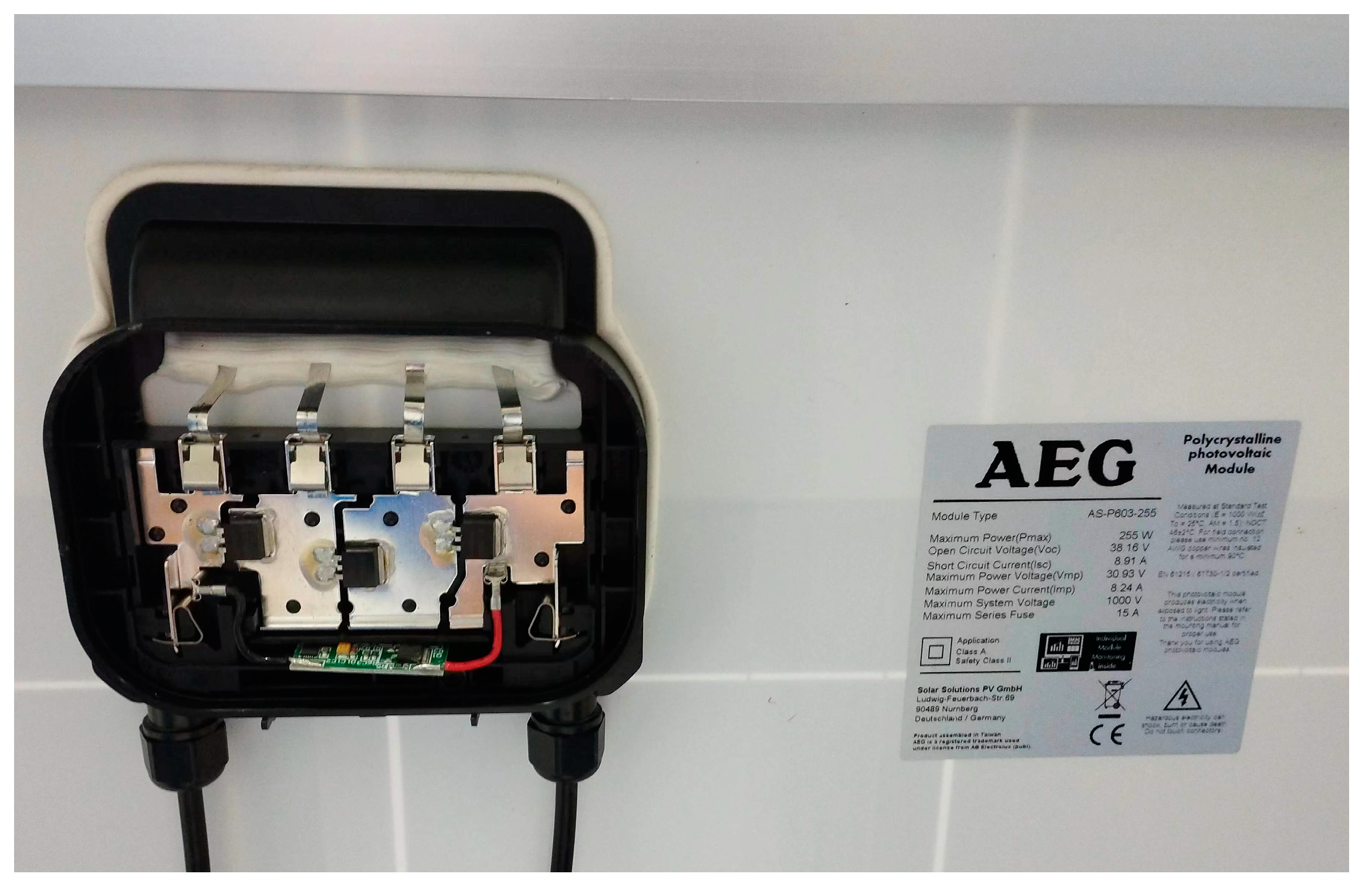

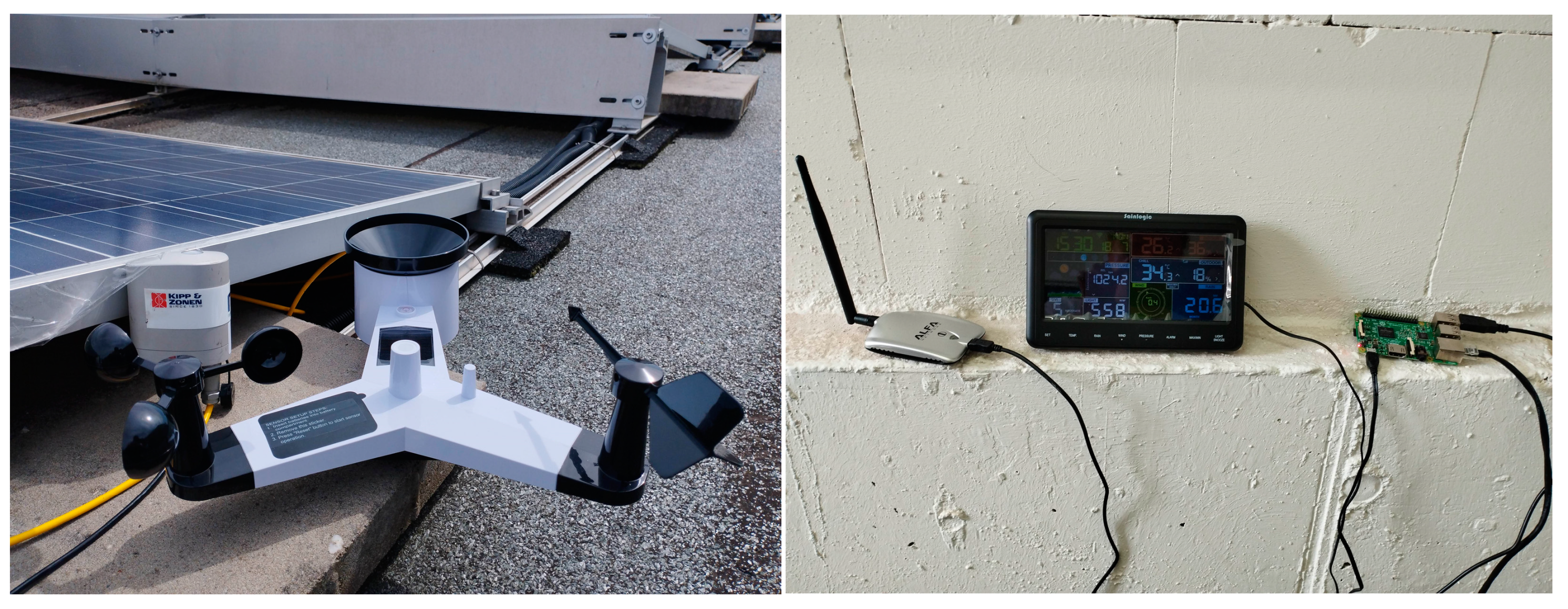
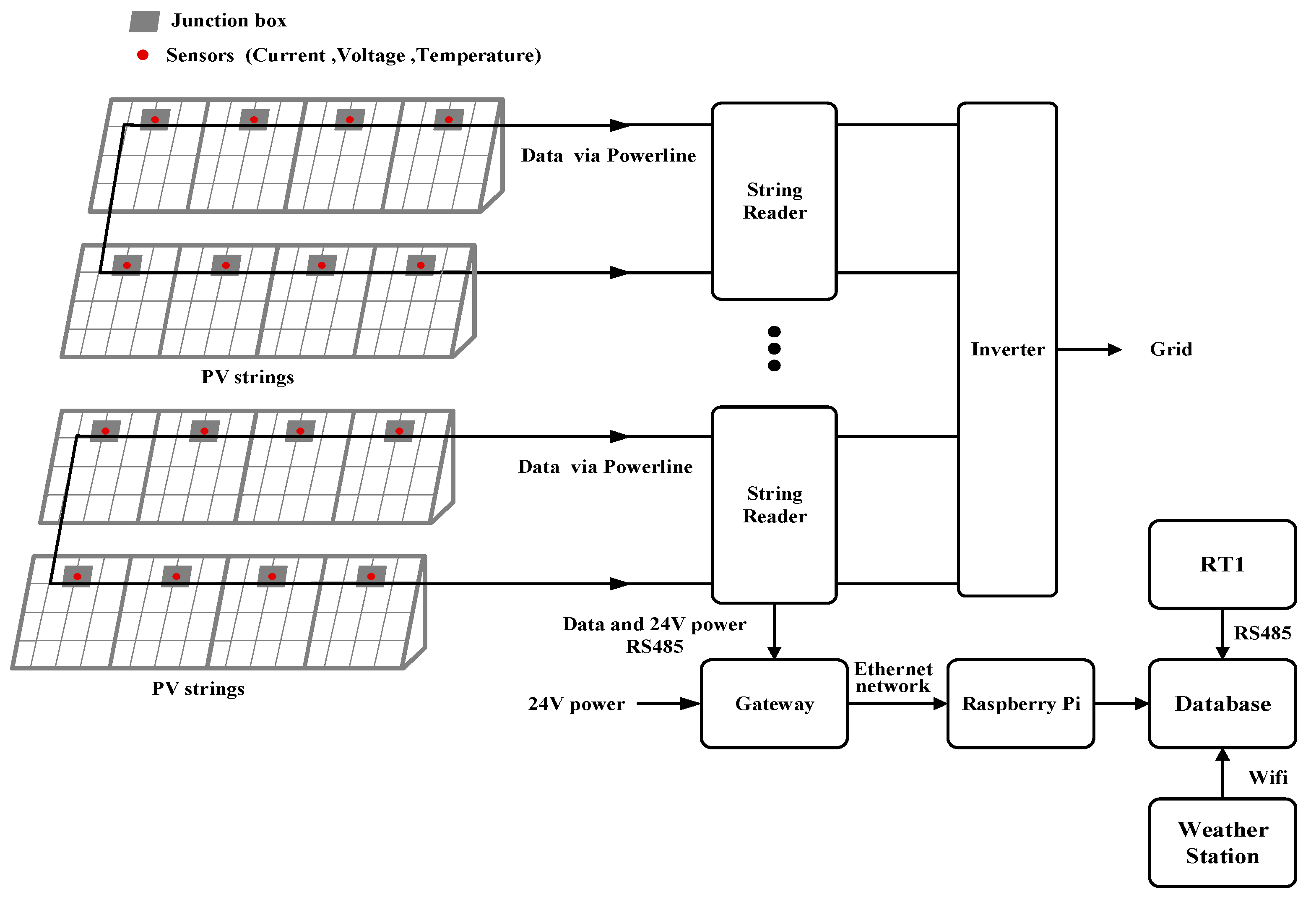
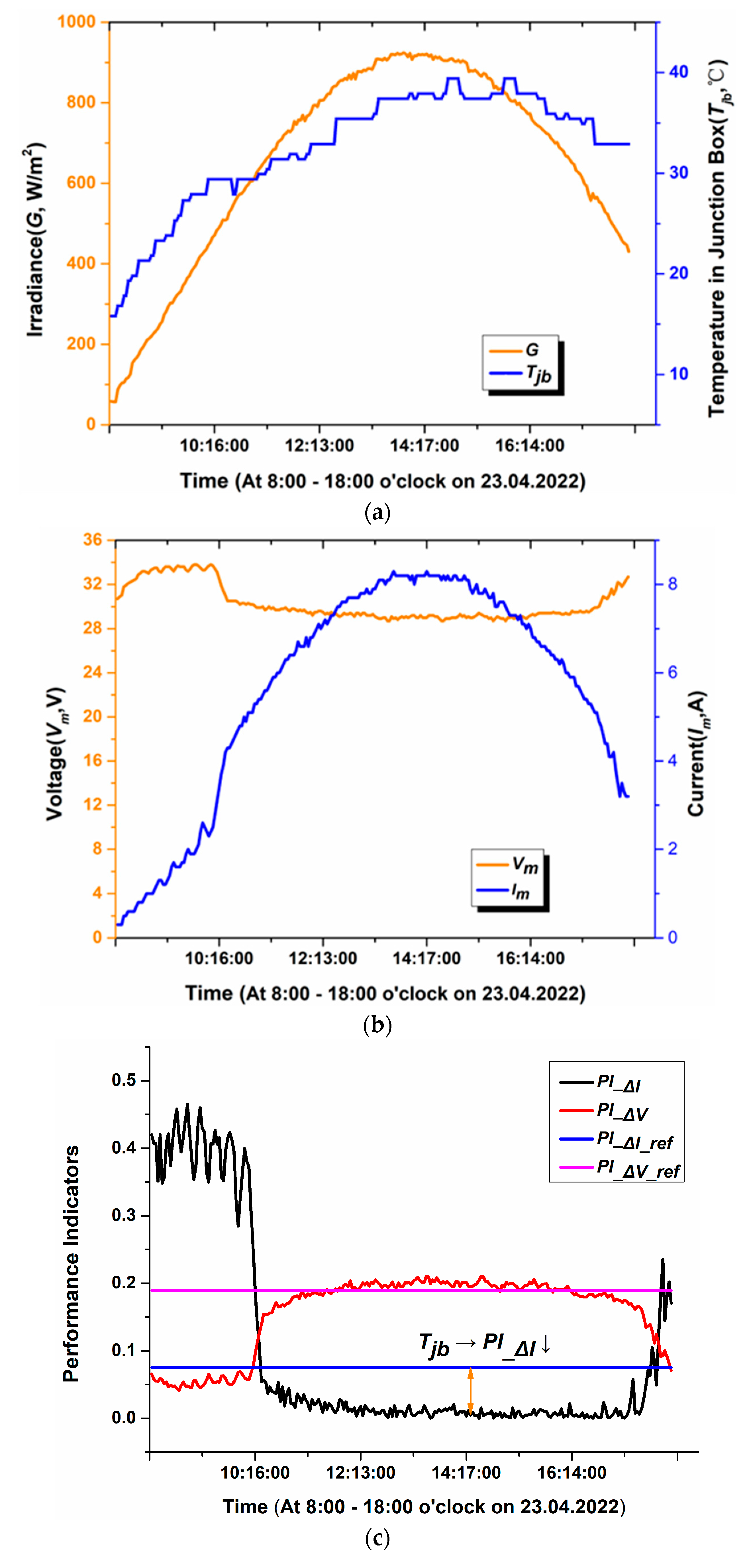
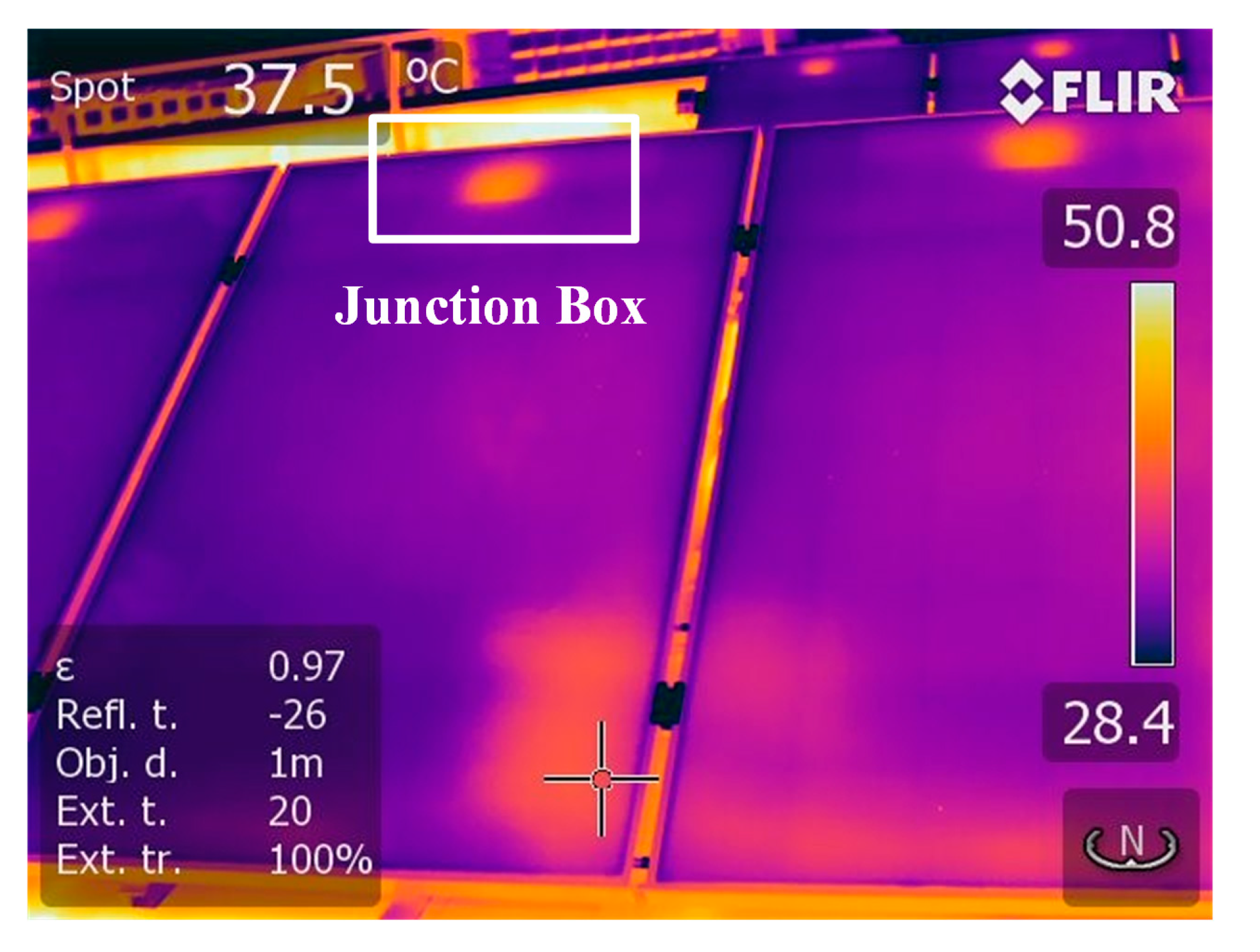
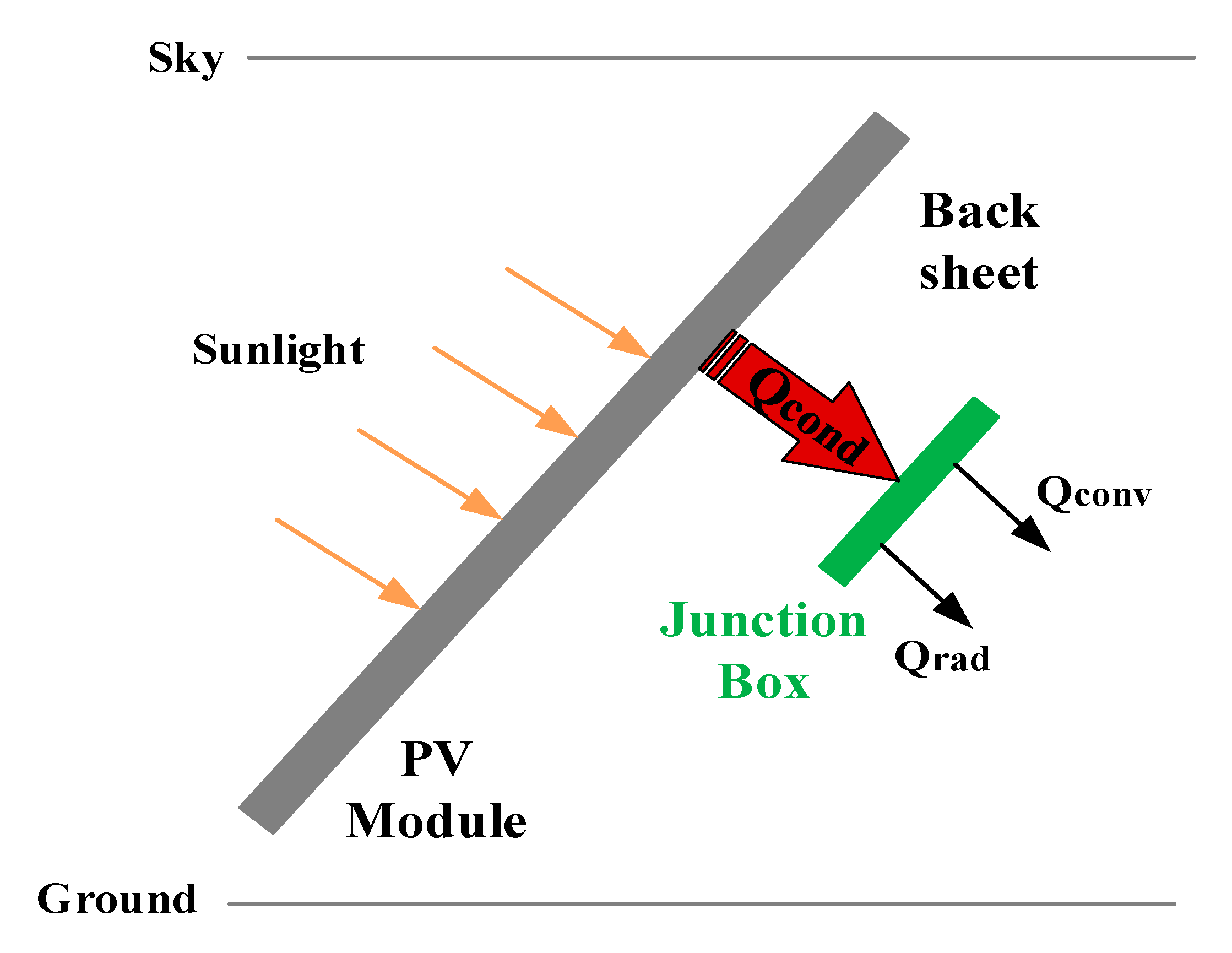
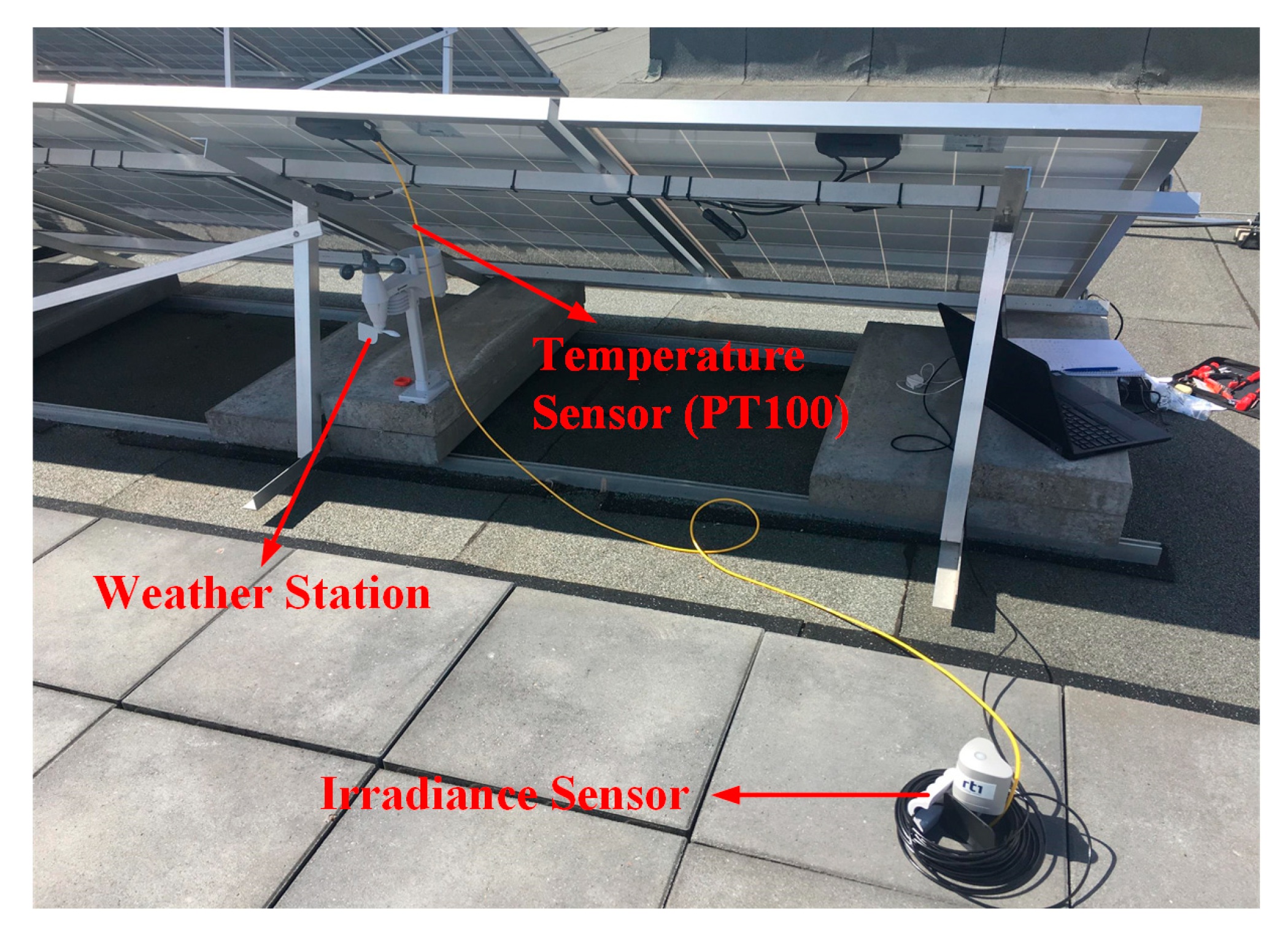
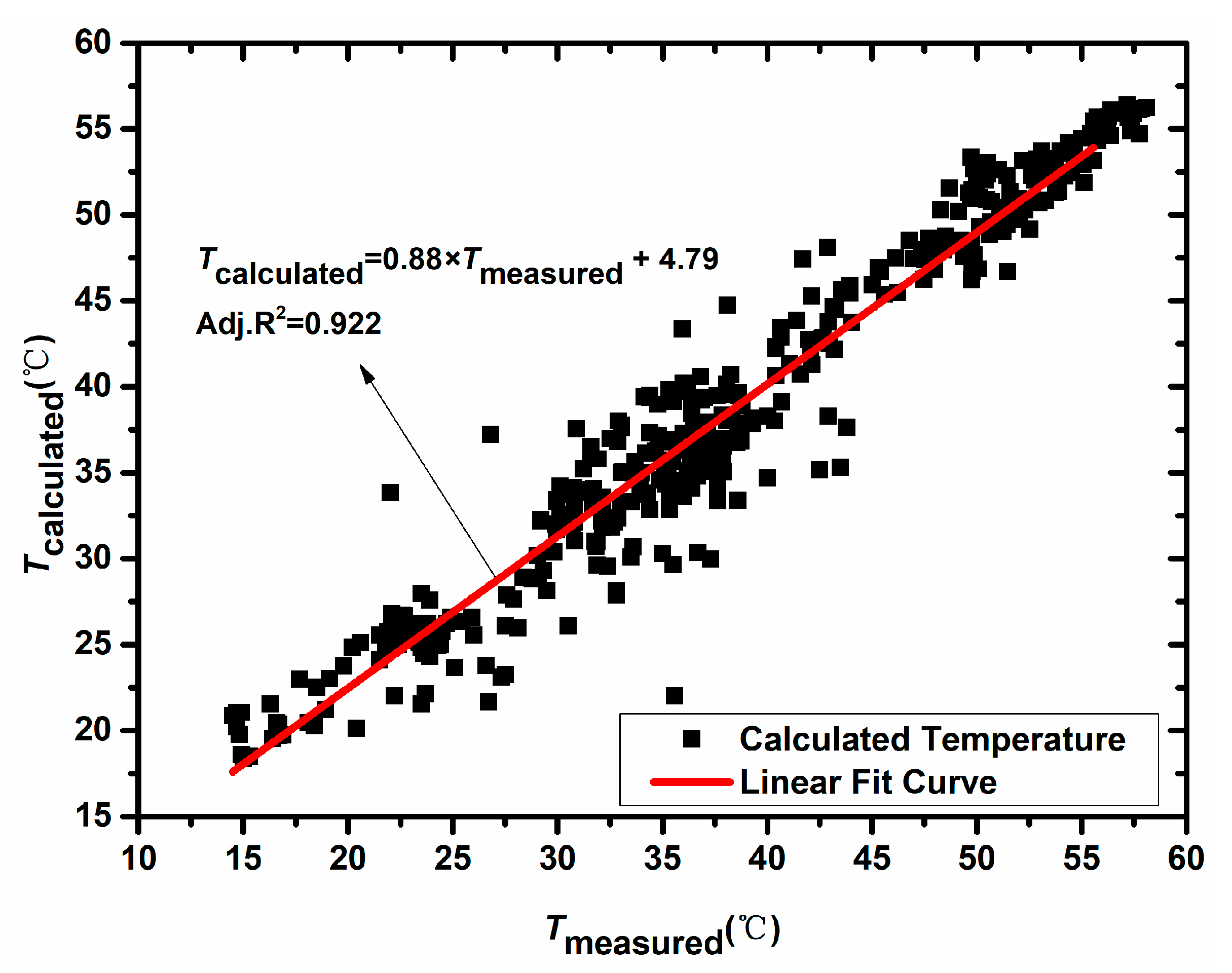
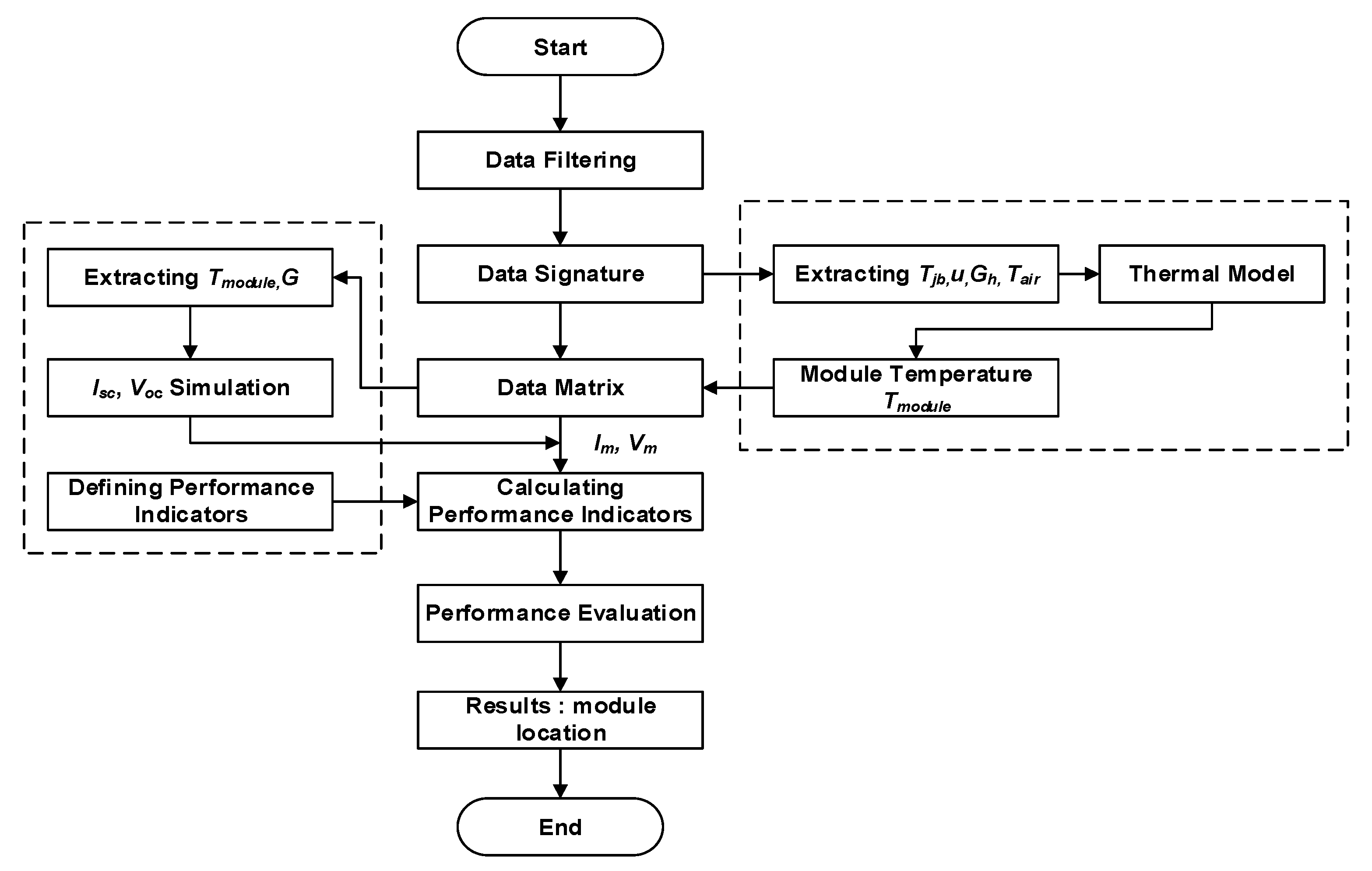
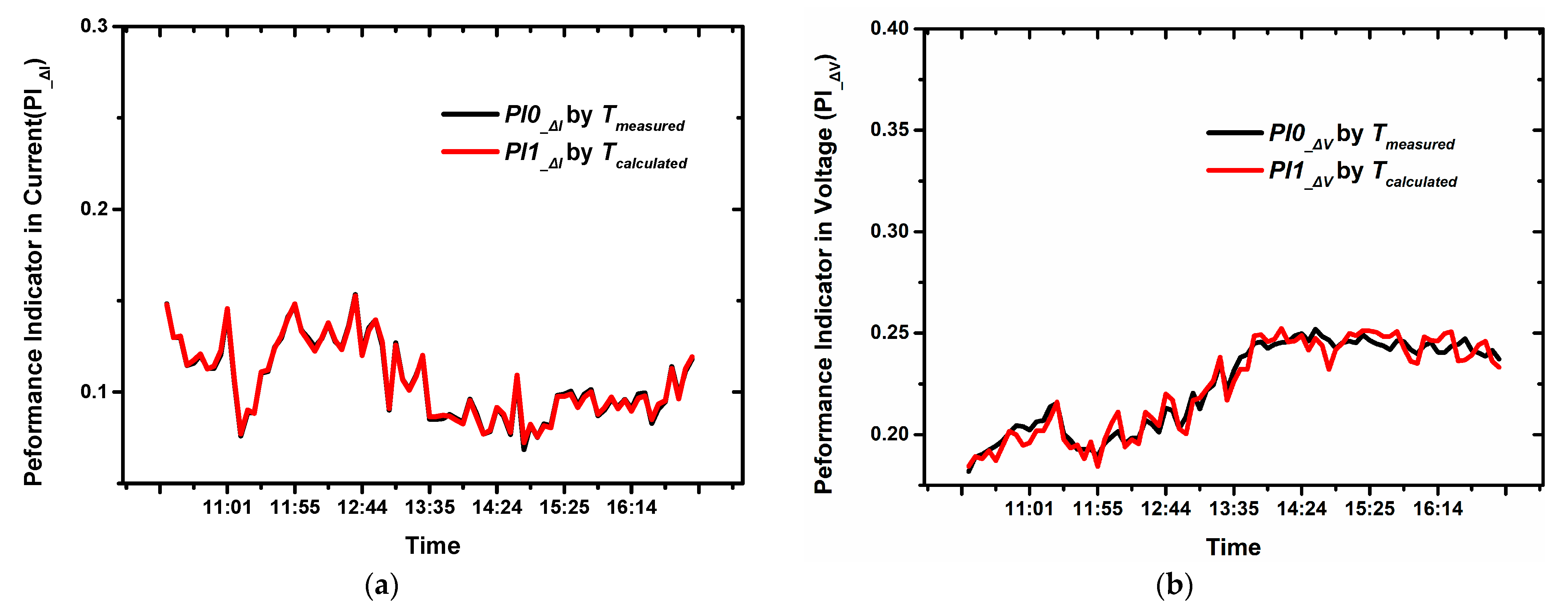
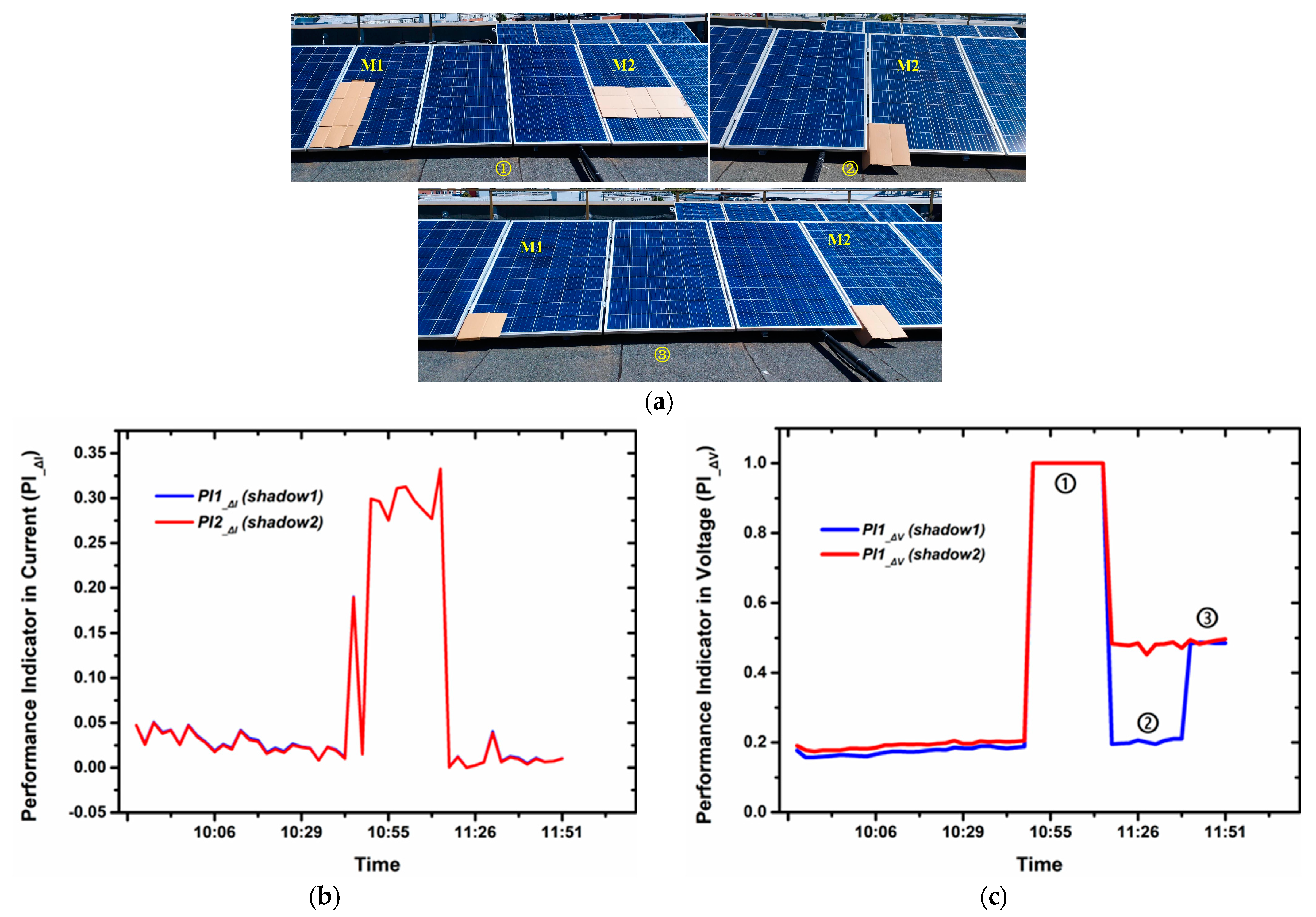
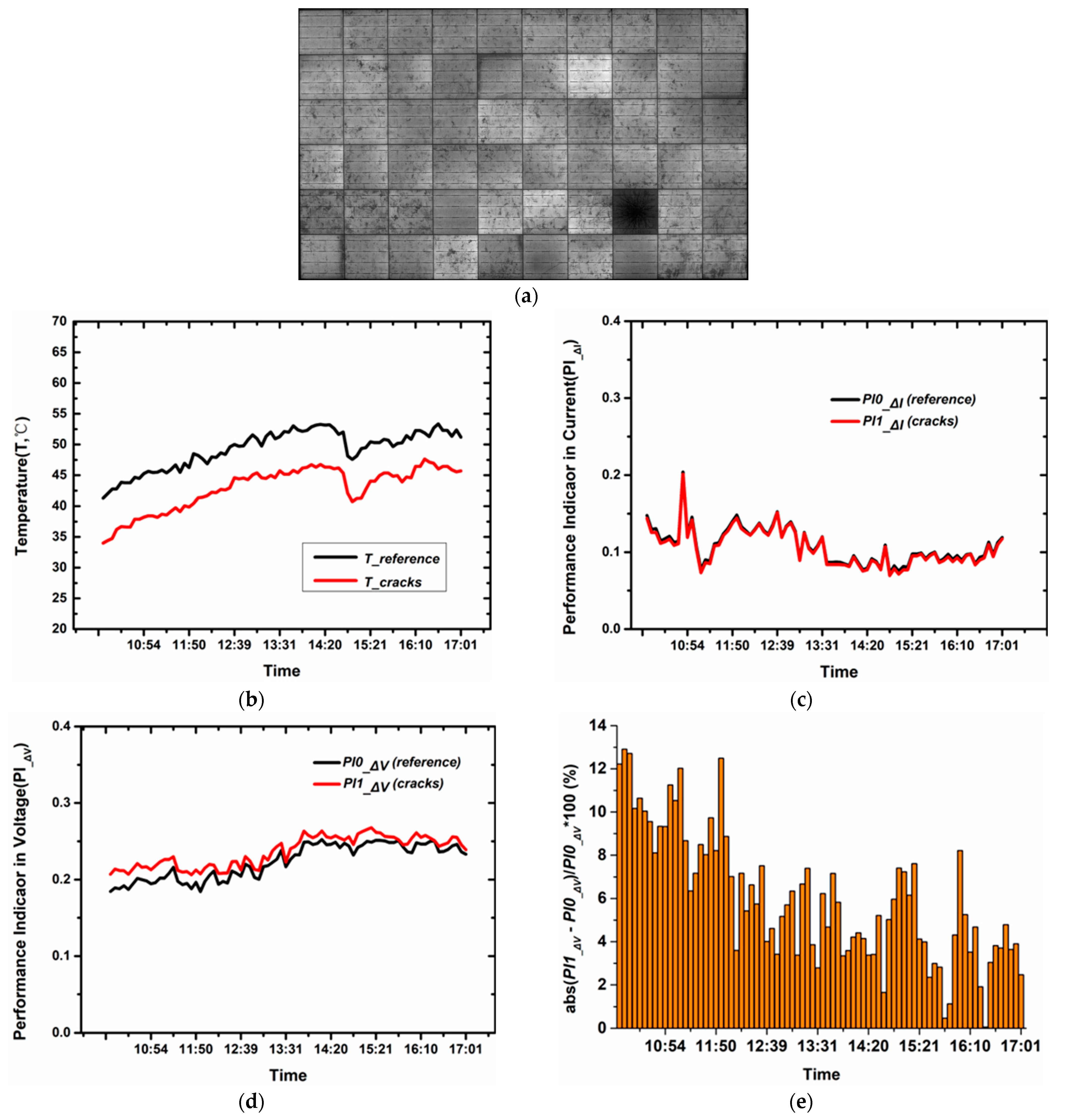


| Parameters | Variable | Values |
|---|---|---|
| Maximum Power | Pm,ref | 255 W |
| Voltage at MPP | Vm,ref | 30.93 V |
| Current at MPP | Im,ref | 8.24 A |
| Open Circuit Voltage | Voc,ref | 38.16 V |
| Short Circuit Current | Isc,ref | 8.91 A |
| Temperature Coefficient of Isc,ref | α | 0.06%/℃ |
| Temperature Coefficient of Voc,ref | β | −0.33%/℃ |
| Irradiance Correction Coefficient of Voc,ref | a | 0.06 |
| Solar Cells | -- | 60 |
| Bypass Diodes | -- | 3 |
| Faults | Performance Indicators | System ID | String ID | Module ID | Detection |
|---|---|---|---|---|---|
| Cracks | PI_ΔV = 0.22 | PVS1 | S5 | BG033404 | √ |
| Shadow | PI_ΔV = 0.47 | PVS1 | S5 | BG033061 | √ |
| Broken sensors | PI_ΔI = 0.17, PI_ΔV = 1 | PVS1 | S6 | BG033269 | √ |
| Faultless | PI_ΔI = 0.09, PI_ΔV = 0.2 | PVS1 | S5 and S6 | Others | -- |
Disclaimer/Publisher’s Note: The statements, opinions and data contained in all publications are solely those of the individual author(s) and contributor(s) and not of MDPI and/or the editor(s). MDPI and/or the editor(s) disclaim responsibility for any injury to people or property resulting from any ideas, methods, instructions or products referred to in the content. |
© 2023 by the authors. Licensee MDPI, Basel, Switzerland. This article is an open access article distributed under the terms and conditions of the Creative Commons Attribution (CC BY) license (https://creativecommons.org/licenses/by/4.0/).
Share and Cite
Feng, L.; Amin, N.; Zhang, J.; Ding, K.; Hamelmann, F.U. Module-Level Performance Evaluation for a Smart PV System Based on Field Conditions. Appl. Sci. 2023, 13, 1448. https://doi.org/10.3390/app13031448
Feng L, Amin N, Zhang J, Ding K, Hamelmann FU. Module-Level Performance Evaluation for a Smart PV System Based on Field Conditions. Applied Sciences. 2023; 13(3):1448. https://doi.org/10.3390/app13031448
Chicago/Turabian StyleFeng, Li, Nowshad Amin, Jingwei Zhang, Kun Ding, and Frank U. Hamelmann. 2023. "Module-Level Performance Evaluation for a Smart PV System Based on Field Conditions" Applied Sciences 13, no. 3: 1448. https://doi.org/10.3390/app13031448
APA StyleFeng, L., Amin, N., Zhang, J., Ding, K., & Hamelmann, F. U. (2023). Module-Level Performance Evaluation for a Smart PV System Based on Field Conditions. Applied Sciences, 13(3), 1448. https://doi.org/10.3390/app13031448








